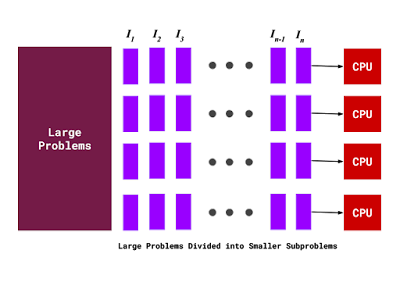Underlying Principles of Parallel and Distributed Computing System
- The terms parallel computing and distributed computing are used interchangeably.
- It implies a tightly coupled system.
- It is characterised by homogeneity of components (Uniform Structure).
- Multiple Processors share the same physical memory.
Parallel Processing
- Processing multiple tasks simultaneously in multiple processors is called parallel processing.
- Parallel program consists of multiple processes (tasks) simultaneously solving a given problem.
- Divide-and-Conquer technique is used.
Applications for Parallel Processing
- Science and Engineering
- Atmospheric Analysis
- Earth Sciences
- Electrical Circuit Design
- Industrial and Commercial
- Data Mining
- Web Search Engine
- Graphics Processing
Why to use parallel processing
- Save time and money: More resources at a task will shorten its time for completion, with potential cost savings.
- Provide concurrency: Single computing resources can only do one task at a time.
- Serial computing limits: Transmission speeds depend directly upon hardware.
Parallel computing memory architecture types
- Shared memory architecture
- Distributed memory architecture
- Hybrid distributed shared memory architecture
1. Shared Memory Architecture
- All processes access all memory as a global address space.
- Multiple processors can operate independently but they share same memory resources available.
- Change in my location - affected by processor.
- Shared memory is classified into two types,
- Uniform Memory Access (UMA)
- Non-Uniform Memory Access (NUMA)
Uniform Memory Access (UMA)
- It is represented by symmetric multiprocessor machines
- Identical processes equal access and access time to memory
Non-Uniform Memory Access (NUMA)
- It can directly access the memory of another SMP.
- Equal access time to all memories.
- Memory access across the link is slower.
- It is a global address space.
- User friendly programming prospective to memory.
- Data sharing between tasks is both fast and uniform due to the memory CPU.
- Scalability between memory and CPU
- Increases traffic associated with cache or memory.
- Synchronisation constructs the correct access to global memory.
2. Distributed Memory Architecture
- A distributed system is a collection of large amount of independent computers that appear to its users as a single coherent system.
- Distributed Systems have their own local memory
- Memory is scalable with the number of processors
- Processes can be accessed rapidly with its own memory without any interference
- Cost effective use of commodity processors and networking
- Disadvantages
- The programmer is responsible for many of these details associated with data communication between processes
- Non-uniform memory access time data residing in a remote node to access local data
3. Hybrid distributed shared memory
- The shared memory component can be a shared memory machine or Graphics Processing Unit (GPU).
- Distributed memory components used in networking of multiple shared memory on GPU machines
Advantages
- Increase scalability.
- Whatever is common to both shared and distributed memory architecture.
Disadvantages
- Increased programmer complexity is an important disadvantage.



إرسال تعليق